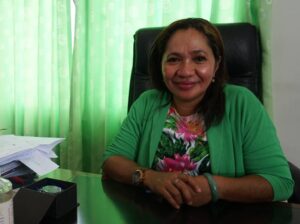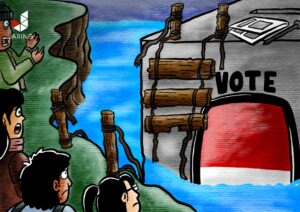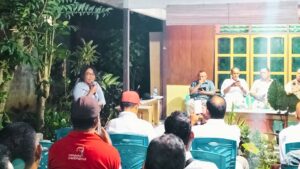A citizen journalist, Felix K. Nessi still remembers how the police labeled the news published by lekontt.com as fake news in the past 2020. At the previous time, the East Nusa Tenggara-based alternative media which was built by the Leko Kupang Community in 2018 highlighted the demonstrations carried out by residents of former East Timorese refugees – now called Timor Leste. They demand certainty over the rights to the land they have lived in for more than two decades. This former Timor Leste refugee previously voted for an exodus to Indonesia when the East Timor referendum was held in 1999. The number is estimated to be hundreds of thousands of people. Most of them live in several refugee camps, among others in Noelbaki, Naibonat, Haliwen and Ponu.
On the last year’s demonstration, it was reported that six residents were injured, one of whom is suspected to have been shot as a result of the violence allegedly carried out by the police. “We’ve got the information from our friends in the refugee camps. They asked for help with bringing this news up because no other media is willing to cover this issue,” Felix said when interviewed on Wednesday, September 22, 2021.
Even so, at that time the journalist team from Leko NTT could not directly confirm the news to the field because the distance between Kupang and the refugee camp was about 300 kilometers. Leko NTT was also constrained by the tropical cyclone Seroja, which cut off access to refugee camps. Therefore, confirmation of the violence by the police officers was done via telephone.
After it was published, according to Felix, the news became a conversation in cyberspace after it was spread on social media. But not long after, videos emerged of confessions from the victims who stated that there was no shooting during the demonstration. The police denied and ensured that their members did not repress the residents. “The video was buzzing on Facebook. Through it, people question our news,” Felix said when interviewed on Wednesday, September 22, 2021.
The police statement was then widely quoted by the mainstream media in Kupang. In the release, the police stated that they would take action against the media that spread hoaxes. This incident, according to Felix, made Leko NTT equated with a propaganda media established by politicians and groups for certain interests. “We are equated with fake media,” said Felix.
Since then, citizen journalists in Leko NTT have always been asked for a press card when they want to ask for confirmation from the government. “This concerns the trust of the people of NTT. Print media is more trusted. Citizen journalists just like us still have to find and show the difference with other online media. This is a tough duties and it will take a long time,” he said.
“After that case, we’ve learned to be more careful and to apply the correct journalism standards,” Felix added.
The Secretary General of the Jakarta-based Alliance of Independent Journalists (AJI), Ika Ningtyas said that the labeling of fake news has increasingly been addressed to journalists. The same goes for citizen journalists. According to her, the labeling of hoaxes on news appeared for the first time in 2019. At that time there was an act of racism against Papuan students. Reuters and Jubi who reported if there is a dead people in riots in Papua had been victims of this labeling. Even Kompas, which in 2021 reported that a patient died due to a lack of oxygen in one of the regional hospitals was also labeled a hoax. “This has never happened before. In addition to the media and civilians who are making fact-checking movements, the government has also set up anti-hoax channels such as Ministry of Communications and Informatics, Headquarters of National Police and the TNI,” She said on Saturday, September 25, 2020.
Through these channel, according to Ika, the government is trying to monopolize the truth. Information that is deemed not in accordance with the government’s agenda is easily labeled as a hoax. This phenomenon is also massive for activist circles. One of them happened to a human rights lawyer, Veronika Koman when she posted news about the arrest of Papuan students in Surabaya. The photo of the violence against students in Papua that environmentalist activist Dhandy Dwi Laksnono shared was also labeled a hoaxes and Dhandy was arrested by the security forces. Likewise, activists who voiced their rejection of the Job Creation Bill or known as the Omibus Law were arrested and their criticisms were marked as hoaxes.
Instead of labeling the news as a hoax, according to Ika, both the government and the public who feel that the reports of the media are inaccurate can immediately clarify it through the right of reply. Another mechanism that can be taken is by reporting it to the Press Council. According to her, the practice of labeling hoaxes on media news can actually threaten press freedom. “This is one of the threats to the press freedom, this is happening globally how the government monopolizes courage and delegitimizes the work of journalists,” Said Ika.
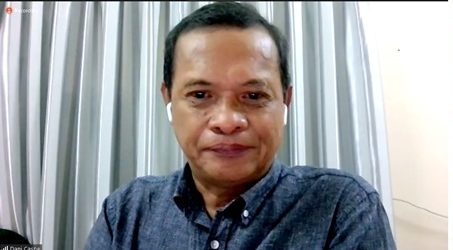
Not only in Indonesia, other media in Southeast Asia are also facing the same issue. Director of the Cambodian Center for Independent Media (CCIM) Danilo Caspe said the press freedom in Cambodia was threatened since the government passed a number of regulations. These bills include the decision to call a national internet gateway or center to control the entire internet network in Cambodia, the Cyber Crime Act, as well as rules and warnings for social media users against “fake news.”
With the rule, the government can easily attach a hoax label through the Cambodian Ministry of Information. This ministry has an internal unit that monitors fake news. This unit controls not only the press, but also over the all social media activities of citizen journalists and the public. “We don’t know the government’s standard of stating a news story is a lie. The only thing that is certain is that all news containing criticism is considered fake news,” said Danilo in a workshop entitled Grassroot Democracy: Citizen Journalism Practice in South East Asia, Wednesday, September 22, 2021. This workshop is organized by Indonesia Asossociation for Media Development (Perhimpunan Pengembangan Media Nusantara/PPMN) under The Asia-Pacific Regional Support for Elections and Political Transitions (RESPECT) program.
Danilo said citizen journalism is no different from professional journalists who must be able to include evidence, as well as verify in the field. To avoid a lawsuit, CCIM will verify all reports of citizen journalists. Reports of citizen journalists who pass the verification will be published on vodenglish.news—the media managed by CCIM. “In the training, we will make sure that they get basic material on journalism, ethics, technology, and social media, digital security, human rights, and religion. After the training, then we invite them to join the coverage,” he said.
Meanwhile, the Chief Editor of CJ.my Malaysia, Maran Parianen, encouraged citizen journalists to increase their capacity. “It is not enough to increase the capacity at once session. It must be done routinely so that over time they become more credible and unbiased,” Maran said.
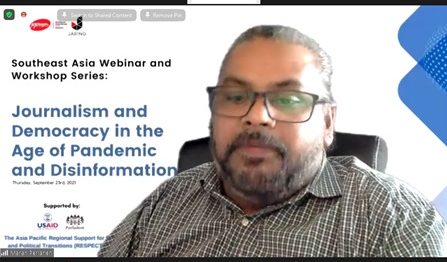
The reason is that as an independent media, according to Maran, citizen journalists are very vulnerable when dealing with the law. For example, in Malaysia, the government recently arrested two activists on charges of disseminating fake news. However, because the two activists had evidence, the police could not make any arrests. Maran believes that similar cases do not only occur in Malaysia. Activist groups and journalists in the Southeast Asian region, such as Singapore, Vietnam, Thailand, Myanmar, and Indonesia, are threatened by similar regulations. “My advice, get back to basics. Make sure you cover everything properly and keep the evidence,” said Maran.
Maran assessed that it was time for citizen journalists to focus on issues that were happening in the community. In reporting on elections, for example, citizen journalists need to look from the perspectives of the community, such as the rights of marginalized groups, the spread of racial issues, and election regulations that affect the community. “This is to reposition their focus. Because citizen journalists have the power to shape how we see the world, explain fundamental issues, and create policy change from the ground up,” he said.
Since its establishment in 2008, CJ.my has had 400 citizen journalists with 150 of them actively transmitting the information. They focus on issues of community, religion, ethnicity, and other issues that do not appear in the mainstream media. More than 80 pieces of training were conducted for citizen journalists in Malaysia. To date, they have produced 1900 videos and 2000 articles, some of which have been distributed through Malaysiakini.


